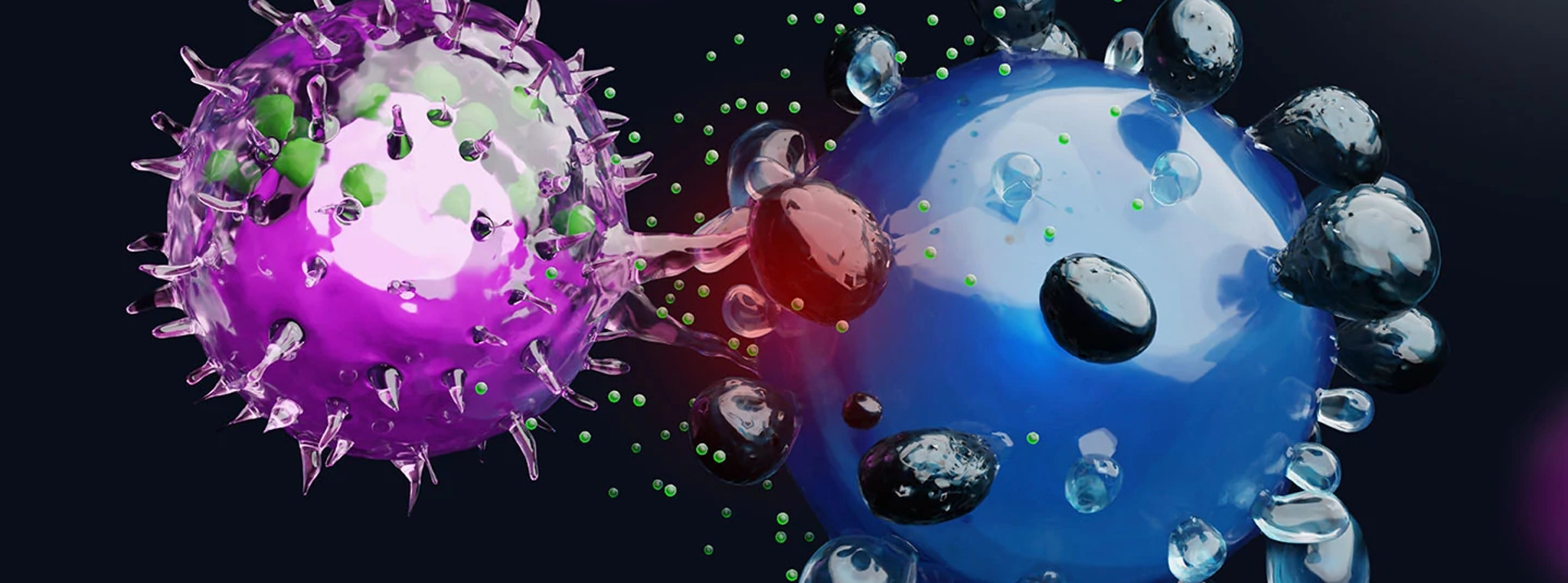
Could natural killer cells build the foundation for a new vision of immunotherapy?
July 18, 2023
CAR T-Cell Therapy
Head and Neck Cancer
Acute Myeloid - AML
by Beth Dougherty
In 1989, an article in Nature billed natural killer (NK) cells as primitive elements of the immune system. These cells, which are part of our innate immune system, were thought to be ancient precursors of our advanced and formidable adaptive immune system, which includes T cells and B cells.
That idea was incorrect.
It turns out that NK cells evolved to be what they are today after the rise of the adaptive immune system. They have many sophisticated features that make them potentially even more formidable than T cells when it comes to fighting cancer.
Scientists had recognized that NK cells play a role in fighting cancer in the 1970s, even before they had a name for the cells. But, for a time, T cells ended up getting all the attention. And not without progress. The advent of T-cell therapies has changed the way oncologists think about treating certain forms of blood cancer.
Now, however, NK cells are back in the spotlight – in part because T-cell therapies have brought challenges that NK cells might be able to overcome. NK cells normally don't live very long, but at any given moment there are about 2 billion of them circulating in the human body. They're on patrol, looking for abnormal cells and invaders and destroying suspects by tearing holes in their cell membranes. They fly under the radar and act without some of the ill effects of T cells in large numbers, such as overstimulating the immune system or causing inflammation in the brain.

In the early 2010s, Rizwan Romee, MD, learned how to prime these stealth fighters so they'd live longer and form memories. In other words, he found a way to make them smarter. As a first step, he made them more like T cells – but without the downsides. Since then, that foundational work has given rise to multiple forms of NK cell therapy, which Dana-Farber oncologists are now testing in clinical trials.
"As we get better at hacking the genetic programs of immune cells, we're making them smarter and smarter," says Romee, director of Dana-Farber's Haploidentical Donor Transplant Program. "It's advancing slowly but steadily."
The vision isn't so much that NK cells will become the new "It" therapy (though they might, for a time). The idea is that NK cells, T cells, all human immune cells, are incredibly powerful. Researchers are for the first time tapping into that power, harnessing it, and bending it to their will to combat cancer in a completely new way – our own body's way, with some artificially introduced, genetically engineered intelligence built in.
"Cell therapy is just going to get bigger and bigger," says Romee. "We don't know which immune cells will do the most for any given malignancy yet, but I don't think there will be winners and losers. It's going to be a win-win."
Collaborating to Explore New NK Cell Uses

In 2019, Romee introduced himself to Dana-Farber colleague Glenn Hanna, MD. He'd heard that Hanna, a director in the Head and Neck Treatment Center at Dana-Farber Brigham Cancer Center, was thinking about NK cells as a potential therapy for head and neck cancers.
Romee at that time had early clinical evidence of positive effects of memory-like NK cells on patients with treatment-resistant AML who did not qualify for a bone marrow transplant because they were at too high a risk of relapse.
These patients have reached the end of their options and have very aggressive disease. But in Romee's phase 1 trial, memory-like NK cell therapy helped some of those patients achieve remission.
Hanna also works with patients who have few options. His patients have head and neck cancer. When they have advanced disease, the first line of therapy, which includes traditional immunotherapy, has only a 20% response rate.
But Hanna had the loose threads of an idea that NK cell therapy might work in head and neck cancers because NK cells have been found in head and neck tumors. "There are a lot of these cells, enough for us to begin wondering about their relevance," says Hanna.
Hanna had – like many other oncologists treating patients with solid tumors – been interested in CAR T-cell therapy for solid tumors, such as head and neck cancers. But getting CAR T cells to specifically recognize head and neck tumor cells and not any other cells in the body was a high bar. A second challenge would be getting them out of the bloodstream and into the head and neck tumors, which tend to be hard to penetrate because they have abnormal blood vessels and very little oxygen.
Memory-like NK cells, however, grabbed Hanna's attention. "They persist," says Hanna. "They have their own intrinsic killing potential. They don't always have to be primed. So they have T cell behavior, but also NK cell behavior. It's very interesting."
Hanna and Romee saw the potential and set to turning an offhand first conversation into a clinical trial.
Examining the Anti-Cancer Effects of NK Cells
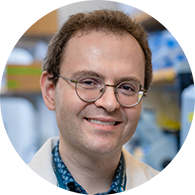
Romee's introduction to Hanna was one of many such moments Romee has had since joining Dana-Farber. These chance meetings of the mind have turned into a confluence of ideas and plans, like streams joining one by one to form an actively flowing river.
Around the same time Romee met Hanna, for example, he had a similar meeting with Roman Shapiro, MD. Shapiro had joined Dana-Farber as a young investigator training to practice stem cell transplantation. On one of his first days on the job, he ended up chatting with Romee and happened to mention he had an interest in NK cells.
According to Shapiro, a specialist in Hematologic Oncology, NK cells are one of the first types of cells to rebound after a stem cell transplant. As a result, they could fight any cancer that remains immediately after the transplant. "The big challenge is that NK cells don't stick around long enough for a lasting effect," Shapiro says.
But, according to Romee's research, memory-like NK cells do stick around.
Shapiro is now principal investigator in a trial, in collaboration with Romee, to use memory-like NK cells after a bone marrow transplant procedure for patients who relapse. The idea is to try to use the NK cells to provide an anti-cancer effect to shut down the relapsing disease for patients with AML or MDS.
"Not only do these NK cells have potent anti-cancer effects and exhibit a memory-like property, but they last even longer than memory-like NK cells outside of a transplant setting because it's an environment that's very friendly to them," says Shapiro.
NK Cells and CAR T-Cell Therapy
Romee also shared his findings about memory-like NK cells outside of Dana-Farber. About three years ago, at one conference, Jianzhu Chen, PhD, a biology professor at MIT, presented his work immediately after Romee's.
Both presentations addressed emerging challenges with CAR T-cell therapy in patients with AML. "There's a huge unmet need," says Romee. "CAR T has primarily been successful in lymphomas and certain types of leukemias, but beyond that we haven't made much progress."
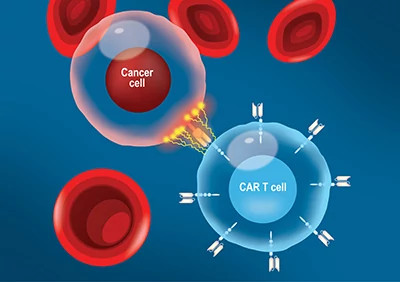
Even in lymphoma, for which CAR T-cell therapy is approved, the cancer comes back in about half of all cases. Either the tumor cells learn to evade the CAR T-cell therapy, or the CAR T cells don't persist in the bloodstream. The two researchers had different – yet complementary – ideas for tackling these challenges.
Chen approached Romee after his presentation and said, "we need to talk."
Chen's engineering team had taken on the challenge of reducing the chances that a tumor cell could evade the therapy. Their plan was to find a way to engineer a T cell to recognize the presence of a specific mutated gene that drives the cancer – an oncogene – in a cell. To do this, they needed to design a synthetic receptor, called a chimeric antigen receptor (CAR), to bind with a portion of the protein created by that oncogene and put it into a T cell to form tumor-specific CAR T-cell therapy.
The oncogene uniquely identifies the cancer, so the engineered T cells would attack the cancer and avoid other cells. In addition, an oncogene is usually essential for the cancer's growth. "The cancer cell cannot easily lose this mutation and become resistant to therapy," says Chen.
In Romee's presentation, Chen saw the advantages memory-like NK cells have over T cells for cell therapy. NK cells have fewer risks of damaging side effects. And memory-like NK cells have been shown to persist in patients in Romee's studies.
"We agreed," says Chen. "We should put our tumor-specific CAR into these memory-like NK cells."
The two have been collaborating ever since.
Romee and Chen had an oncogene in mind. The NPM1 gene is mutated in a specific way in about 30% of patients with AML. But oncogenes like NPM1 create mutant proteins that stay inside the cell. They don't operate on the cell surface.
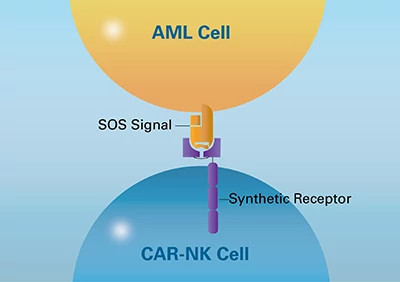
An AML cell (yellow) alerts the immune system with an SOS signal. The CAR-NK cell (blue) has been engineered to have a synthetic receptor (purple) – a chimeric antigen receptor or CAR – that reliably recognizes that specific SOS signal, enabling the CAR-NK cell to find and attack the cancer.
But cells do have a system that presents fragments of abnormal proteins on the cell surface to send an SOS signal to the immune system. Chen's team needed to find a way to create a synthetic receptor, a CAR, that would reliably recognize the specific SOS signal for the mutated NPM1 protein fragment.
The team succeeded. They engineered an antibody that would not only recognize the protein fragment on a cancer cell but also bind to it tightly and persistently, like a pair of super-strong magnets. They then created a CAR based on that antibody.
In collaboration with Romee, they integrated their engineered CAR into memory-like NK cells. "Combining these two is a perfect synergy," says Chen. "We overcome both challenges, to not only target a tumor-specific antigen but also to have our CAR-NK cells persist."
They published positive results from experiments in cell lines and animal models. The data was sufficient to propose bringing the NPM1 CAR-NK cells into the clinic for a trial in patients with AML.
Making Smart NK Cells Smarter
While Romee collaborates widely, he also runs his own lab, which is hosting a team led by Michal Sheffer, PhD, a Sidney Farber research scholar at Dana-Farber. The team is working to understand how NK cells might be engineered to be even smarter.
Sheffer uses CRISPR gene editing technology to screen NK cells to find out what features make NK cells more effective killers and what holds them back. In an earlier study published in Nature Genetics, Sheffer and colleagues created a whole genome CRISPR gene editing library in which each tumor cell contains one random silenced gene. Then they treated the tumor cells with NK cells to learn which of the silenced genes affected killing. They identified one gene that appears to enhance the sensitivity of tumor cells to killing by NK cells and one that increases resistance.
The team is now doing a similar experiment, but this time their plan is to use CRISPR to silence genes in the NK cell population. The experiment requires the silencing of all the genes that are active in NK cells and uses a novel approach to engineering NK cells that was developed by Romee and Chen.
Ultimately, Sheffer's work, which is still in early stages, is designed to guide researchers in their quest to make NK cells smarter.
"We want to find a way to make sure NK cells survive the harsh tumor microenvironment and get where we need them. When they get there, we want them to recruit other immune cells so they can work together to kill the tumors," Sheffer says.
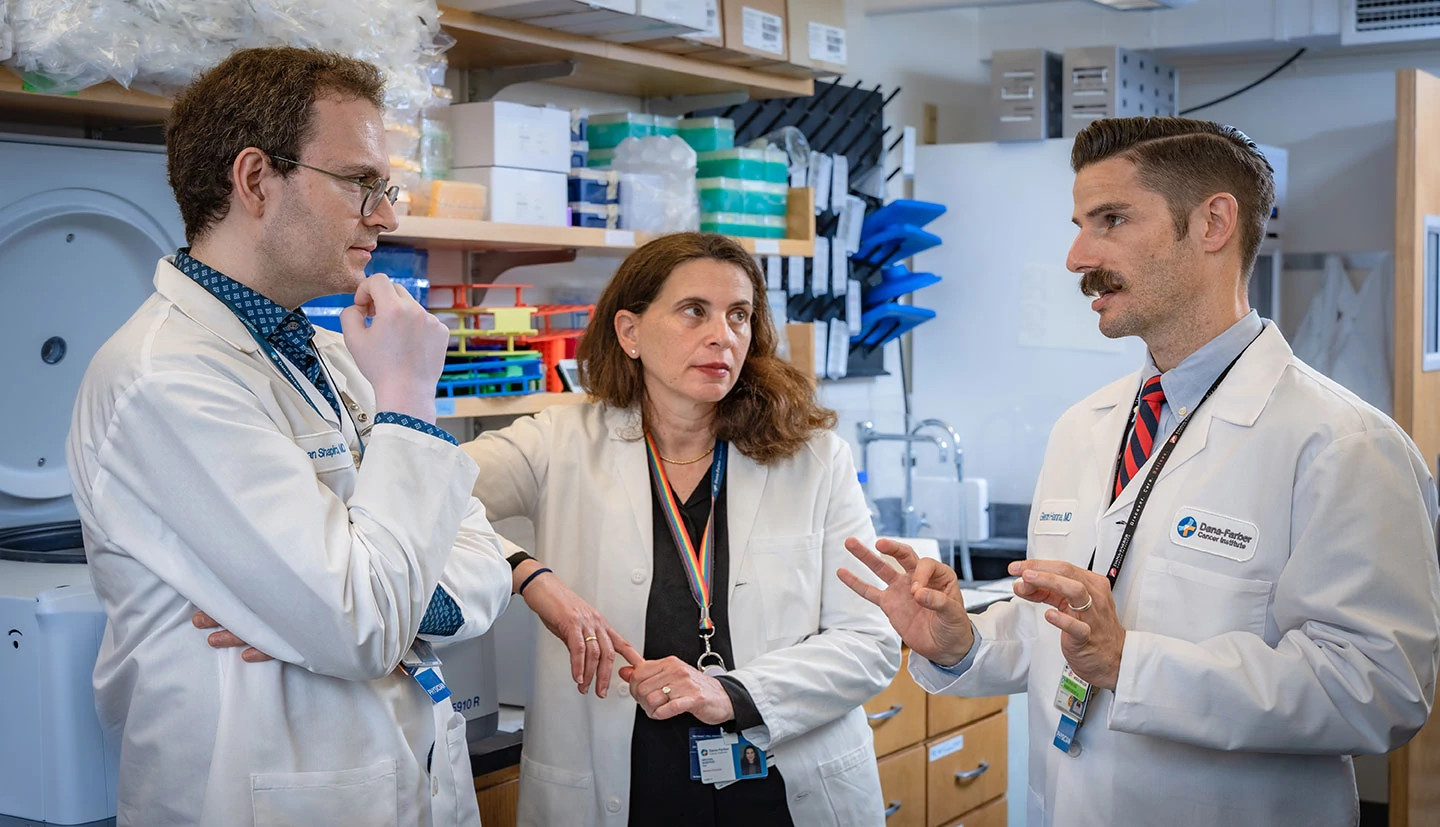
Moving Toward New NK Cell Treatments
From a single idea five years ago, to multiple trials and many more ideas today, you can practically feel the momentum building behind NK cell therapy and making progress, as Romee said, slowly, steadily.
Hanna's trial in head and neck cancer involved only ten people, all of whom had run out of options for therapy. What he learned from his earliest data, reported in 2022, is that treatment with memory-like NK cells is safe and tolerable in these patients. Additionally, the NK cells persisted in his patients' bloodstreams.
Hanna also saw a small signal of efficacy in some of the patients. "Our goal now is to amp up that efficacy signal," he says.
One approach is to increase the levels of IL-15, a signaling molecule that activates immune cells and is infused along with the NK cell-therapy – "the water that feeds the NK cell crop," as Hanna describes it to patients.
"This is the beginning of the story," says Hanna. "You've got to start somewhere." In Shapiro's trial giving memory-like NK cells to patients who relapse after a stem cell transplant, four out of six patients went into remission, another signal of efficacy. That remission, however, lasted at best for six months.
"Six months is not where we want to be," Shapiro says. "We want a cure."
To take the next step, Shapiro is working with regulators to approve a trial in which the NK cells are given immediately after the bone marrow transplant and before the cancer has time to relapse.
"We want to give a one-two-three punch that could get more of these refractory patients into durable remission," Shapiro says.
Meanwhile, Romee is planning to test the NPM1 CAR-NK therapy he developed in collaboration with Chen in patients with AML sometime next year. He also is working to begin a trial of memory-like NK cells in ovarian cancer.
The momentum is building but delivering on the promise of NK cell therapy isn't necessarily the ultimate goal. Rather, these researchers envision a new kind of immunotherapy, one that does not center around drugs that tweak the immune system. They envision a therapy that does not involve the taking, engineering, and reinfusion of immune cells – that is personalized and accessible.
They speculate that it might someday be possible to understand the immune system well enough to know how smart it needs to be to defeat an individual's cancer, and to administer gene therapy that makes a patient's immune system exactly that smart.
"There have been a lot of advances over the last five years," says Chen. "I imagine there will be even more over the coming 10 years."
Along the way, each of those advancements has the potential to touch patients, giving them more options, more hope, and more time to enjoy life.